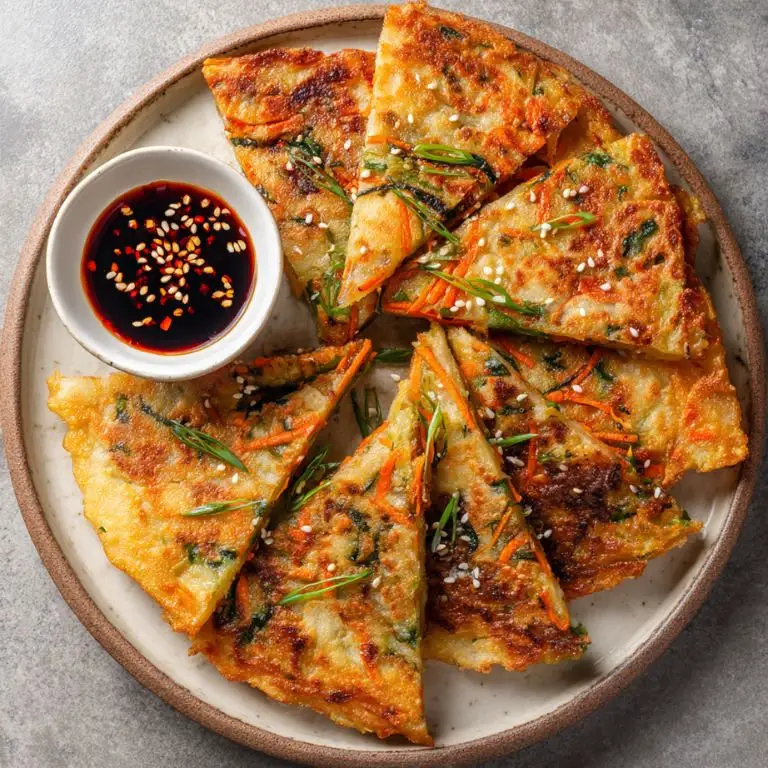There’s something undeniably comforting about biting into a crispy, savory pancake, and korean pancakes with scallions, also known as Pajeon, deliver that satisfaction with a distinctively bold flavor. Popular across Korea as a snack, appetizer, or light meal, Pajeon is a staple in many korean meals and is adored for its golden, crisp exterior and tender, flavorful inside. Whether you’re dipping it into soy-vinegar sauce or enjoying it with a side of kimchi, this pancake captures the heart of korean recipes authentic. It's one of those easy korean recipes that make learning how to make korean food feel effortless and fun.
Crispy Korean Pancakes (Pajeon) with Scallions
Prep Time 15 minutes mins
Cook Time 20 minutes mins
Total Time 35 minutes mins
Course Appetizer, Side Dish, Snack
Cuisine Korean
Servings 2 large pancakes (enough for 3-4 people as an appetizer or 2 as a main)
Mixing bowls One medium bowl for the batter and one for the dipping sauce.
Whisk or Fork To mix the batter until smooth.
Sharp knife and cutting board For slicing scallions and vegetables.
Nonstick skillet or cast iron pan A nonstick surface is essential for crispiness and easy flipping. A cast iron skillet works even better for achieving the ideal golden crust.
Spatula A wide, flat spatula is perfect for flipping the pancake without tearing it.
Measuring cups and spoons Precision helps, especially when making the dipping sauce.
- 1 cup all-purpose flour
- 1/2 cup rice flour gives a lighter, crispier texture—optional but recommended
- 1 1/4 cups cold water
- 1 egg
- 1/2 teaspoon salt
- 1 bunch scallions trimmed and cut into 3-4 inch strips
- 1/2 cup thinly sliced onions
- 1/2 cup julienned carrots for sweetness and color
- 1/2 cup thinly sliced zucchini optional, but adds a nice texture
- 1 small chili pepper thinly sliced (optional for a spicy korean kick)
- Vegetable oil for frying
For the dipping sauce
- 2 tablespoons soy sauce
- 1 tablespoon rice vinegar
- 1/2 teaspoon sesame oil
- 1/2 teaspoon sugar
- A pinch of red pepper flakes or gochugaru optional
- 1 teaspoon finely chopped scallions
Make the Batter
In a medium mixing bowl, whisk together the all-purpose flour, rice flour, salt, and water. Crack in the egg and whisk until you get a smooth, pourable batter. It should be slightly thicker than crepe batter but thinner than pancake batter.
Add the Vegetables
Stir in the scallions, sliced onions, carrots, zucchini, and chili pepper. Mix well so everything is coated evenly with the batter. The vegetables should be generously present in every spoonful.
Heat the Pan
Add 1-2 tablespoons of vegetable oil to your skillet and heat over medium-high. Once the oil shimmers, it's ready.
Cook the Pancakes
Scoop about half of the batter into the pan and spread it into a thin layer. You should hear a satisfying sizzle. Press it down slightly with your spatula. Cook for about 3-4 minutes on one side, or until the bottom is golden and crispy.
Flip carefully and cook the other side for another 3-4 minutes. The pancake should be golden brown and slightly puffed, with crispy edges and soft, steamy insides. Repeat with remaining batter.
Make the Dipping Sauce
While the pancakes are cooking, whisk all the dipping sauce ingredients together in a small bowl. Taste and adjust as needed—it should be salty, tangy, slightly sweet, and, if desired, a bit spicy.
Serve
Slice the pancakes into wedges like a pizza and serve immediately with the dipping sauce on the side. Garnish with a few extra scallion slivers or sesame seeds if you’d like.
Pairings
Pajeon is a versatile dish that fits seamlessly into a variety of korean meals. It pairs beautifully with:
- Makgeolli (Korean rice wine): This slightly sweet, milky beverage is a classic match for Pajeon, especially on rainy days.
- Kimchi: The bold, fermented tang of kimchi provides a spicy, sour contrast that balances the savory pancake.
- Korean bibimbap: For a fuller meal, serve Pajeon as a starter and follow it with a bowl of colorful, veggie-packed korean bibimbap.
- Miso Soup or Korean Seaweed Soup (Miyeokguk): Light brothy soups help cleanse the palate between bites.
- Steamed sushi rice: If you're craving something heartier, a side of sticky sushi rice with sesame seeds rounds out the meal.
- Grilled protein: Pair it with grilled tofu, bulgogi beef, or spicy grilled chicken to create a balanced plate.
FAQs
1. Can I use other vegetables in the batter?
Absolutely. Korean home cooks often throw in whatever’s in the fridge—bell peppers, mushrooms, spinach, or cabbage all work. Just keep the veggies thinly sliced so they cook through quickly.
2. Can I add seafood to the Pajeon?
Yes! For a more traditional korea food recipe, add 1/2 cup chopped squid, shrimp, or clams to the batter. This version is known as Haemul Pajeon and is a popular choice at Korean restaurants.
3. What’s the best type of pan to use?
A well-seasoned cast iron skillet gives the crispiest results, but a nonstick frying pan works too. The key is to heat the oil until shimmering and use enough to coat the surface.
4. Is this recipe healthy?
Yes, especially if you use minimal oil and pack it with vegetables. It fits well into healthy korean recipes, offering fiber, vitamins, and low-fat protein if you add seafood or tofu.
5. Can I make the batter ahead of time?
You can mix the batter and store it in the fridge for up to 4 hours. However, for best results, add the vegetables just before cooking to avoid sogginess.
